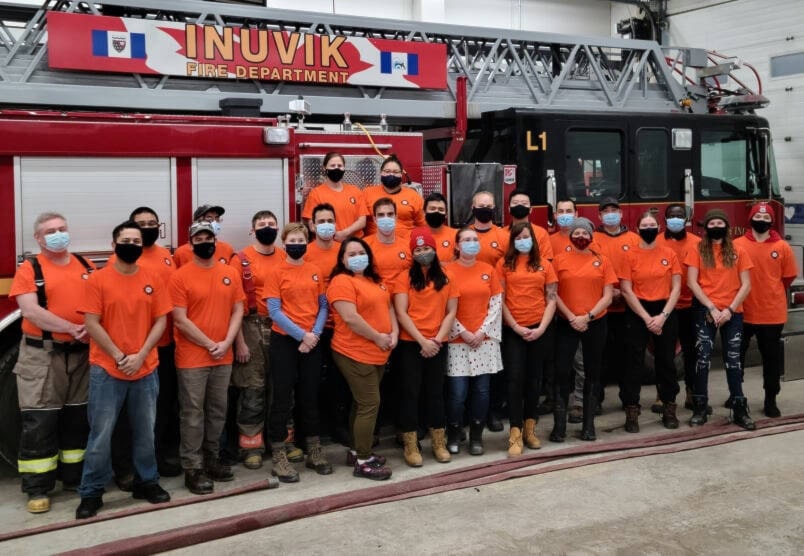It’s been a busy year for the Town of Inuvik Fire Department.
Aside from being just a phone call away when combustion gets critical, the volunteer department has been pushing its recruits to climb to new heights in training and achievement. That involves upgrading long-standing members of the department and bringing its 10 new recruits up to speed.
“Inuvik Fire is heavily committed to training our firefighters to deliver safe, effective, and efficient fire services to our community,” said fire chief Cynthia Hammond. “Recruit firefighters undertake 40 hours of basic training over two weekends in September and October. Topics during recruit training cover fire operations that include, but are not exclusive to: personal protective equipment, communications, ladders, ropes and knots, search and rescue, firefighter survival, vehicle extrication and fire suppression.
“Additionally, they attend regular Fire Department training nights, Wednesdays from 7 to 10 p.m., that generally reinforce many of the basic fire operations topics and curriculum included in the NFPA 1001 Firefighter Professional Qualifications. Further, depending on the annual training schedule, they attend the occasional weekend training sessions.”
Over the course of a year, a firefighter can expect to clock 150 hours of weekly training, plus an additional 40 hours of weekend, live fire and practical training sessions. Firefighters can further their education with specific evening and weekend training courses, which can take from 40 to 80 hours each year.
Hammond said the Inuvik Fire Department trains to the standards of the National Fire Protection Association (NFPA) — an international non-profit organization that establishes building codes, sets standards for firefighting equipment and operations and oversees firefighter training at the high level. To achieve basic certification under their mantle — NFPA 1001 certification — is an additional 200 hours of training. Because of the time and training commitment, Hammond said the NFPA certification is only available after a full-year with the department.
” While some of the NFPA standards are mandatory through legislation,” she explained. “Others are considered best practices, and are dependant on the needs and circumstances of the community, as well as the type and levels of service set by the Council.
“In saying that, many fire departments, such as Inuvik Fire, choose to follow these standards, to the best of their capability, to demonstrate due diligence. Fire departments use many references, textbooks and other resources based on NFPA standards to deliver fire protection services safely, effectively, and efficiently.”
Financial support for basic NFPA training and becoming a fire instructor is provided by the GNWT. Firefighters who want to punch up to the next level beyond that rely on the Inuvik Fire Department to cover the costs, which can be significant.
“The NFPA 1001 Firefighter program is a primarily online, student-centred, self-directed learning method of delivery that runs over the course of an entire year,” said Hammond. “The theory portion includes a 29-chapter online curriculum, with four written exams. The practical portion is dependant on the fire department to train the students to specific skills.
“They undergo two practical assessments by a College of the Rockies evaluator. One of these is conducted over three days in Inuvik, the other culminating evaluation is conducted over three days in Hay River. Additionally, to receive NFPA 1001 certification, individuals must also successfully complete the three-day NFPA 472 Hazardous Materials Responders, Operations Level course.”
Hammond added firefighters are also trained as emergency medical responders, of which nine have completed the training, and wildfire crew training, of which 16 have completed training.
Specifically, the training completed by firefighters is as follows:
- NFPA 1001 firefighter Professional Qualifications - 12 with four pending
- NFPA 1041 Standard on Fire and Emergency Services Instructor eight people have level I, one person has Level Il
- NFPA 1021 Standard on Fire Officer Professional Qualifications - four people have Level 1 and one person has Level 3
- NFPA 1002 Standard on Fire Apparatus Driver/Operator Professional Qualifications - four, although 10 people are capable of driving and operating the apparatus
- NFPA 1033 Standard on Fire Investigator Professional Qualifications - two people
- NFPA 1035 Standard on Fire and Life Safety Educator Professional Qualifications - one person
- NFPA 1031 Standard on Fire Inspector Professional Qualifications - one pending
- NFPA 472 Standard on Hazardous Materials Responder Professional Qualifications- Operations Level- 16 with three pending; and one person trained to Technician Level – one
- Canadian Red Cross Emergency Medical Responder - 9
“To be certified is a huge time commitment,” she said. “The fire department’s training curriculum is robust. The training is planned quarterly and gives consideration to NFPA standards, available training opportunities presented and seasonal operations.
“Many training providers are not local, and it is costly to bring the trainers up or send individuals away for a course. Having said that, Inuvik Fire Department has invested heavily in training and is fortunate to have many individuals who are committed to put in the hours for training and certification.”
